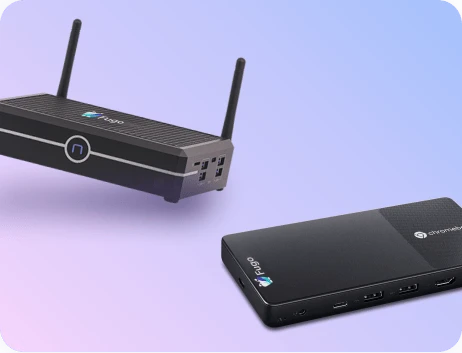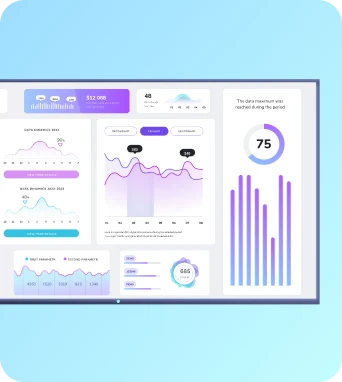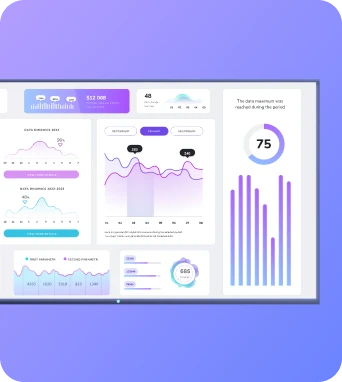You can find digital signage just about everywhere these days — schools, airports, and even gas stations (shout out to those news snippets while you’re filling up). But what we don’t see as often is interactive digital signage: ya know, the kind you can tap, swipe, scan, or talk to through a touch screen interface.
If you've been thinking about upgrading your digital signage with a pinch of interactivity, this guide explains everything you should know about the what, why, and how of interactive digital signage solutions. We also explore why they're different from digital menus, their most efficient use cases, and how to get started for free with Fugo.
But first…
What is interactive digital signage anyway?
Interactive digital signage solutions are digital displays that convey information, entertainment, or advertising through immersive, interactive experiences.
Translation? They're touch screen systems that have some level of interactivity, whether that's the ability to swipe through content, browse virtual products in your store, or skim advertising promotions that may be relevant to the user.
You need a few different types of hardware and software to create interactive digital signage solutions:
- A touch screen interface. Examples could be a TV, large tablets, or a TV wall.
- Digital signage software. A content management system (CMS) is essential for creating, managing, and scheduling digital signage content — like Fugo. 😉
- A digital media player. You need this to broadcast your content to your digital display(s).
Put them all together, and you'll have a powerful interactive display that can help you energize customers, clients, and visitors on a whole different level.
Great, but do interactive display solutions actually matter?
You bet your bottom dollar! Because they're basically digital signage on steroids.
Interactive displays offer all the benefits of traditional signage displays, plus the power of engagement (which does a world of good in the new area of short attention spans).
No need to take our word for it, though. Just check out the numbers.
Interactive digital signage solutions can:
- Increase customer engagement. Digital displays grab 400% more views than static displays alone. Now just imagine its compound interest with interactive display solutions.
- Improve brand awareness. A single brand awareness campaign via digital signage can add around 1,250 social media followers per month. You could try tactics like reducing friction with a QR code, or maybe adding a social media wall for users.
- Create more immersive experiences. You might use interactive displays to help with wayfinding, promoting products, providing coupons, and otherwise building a little intrigue in your brand. This may also improve your customer experience, since you'll have the ability to interact asynchronously with users (more on this later).
- Keep customers around. Compared to static signage, dynamic content improves customer dwell time (aka how long they stick around) by a factor of 2.6x.
- Boost sales. Retailers using interactive interfaces sold 24% more products than those using traditional displays. Revenue also depends on the business in question: some industries (like finance) increase cross-sells and up-sells more aggressively than others (like restaurants).
We could go on, but by now, you get the point. The data shows that interactive digital signage solutions are downright imperative to thriving brands.
The many different types of interactive digital signage experiences
There are (quite literally) dozens of ways to create an interactive digital signage solution, from interactive kiosks and video walls to self-service menus and check-in displays.
But just how many options and use cases are there to choose from?
Let's take a look at some interactive digital experiences you can use to drive interest and income to your business:
Touchscreen content
You probably don't need a reminder of what touchscreen content is — basically any type of device with a screen your audience can touch in some way. This might be tapping to play videos, swiping through images, or even delivering employee training in smaller, bite-sized presentations.
Let's take a closer look:
Endless aisle solutions
One type of interactive touchscreen signage is called an endless aisle solution. In a word, these help customers browse, access, and purchase products beyond what's available in-store.
You can show off a wider range of products with a seamless integration with e-commerce platforms. That way, you can show off products that relate most to your users and use your display to capture their interest and attention.
Self-service menus
Self-service menus create a seamless integration between your signage screens and back-end processes. For example, you might use self-service menus for:
- Ordering food
- Booking appointments
- Reserving timeslots
- Nutritional content of food
- Visitor management (like checking in patients)
Interactive maps and navigation
Let visitors tap through maps or search directories to find where they’re going, or view real-time updates for room assignments, meetings, or event sessions.
For example, if you're a hotel, you might give detailed information visitors can browse about the local area. Or maybe you could give customers more information about where to find what rooms in your building.
QR code integrations
QR codes can give your customers exclusive offers, deliver product information, and provide other interactive content.
For example, you might let customers flip through digital lookbooks or catalogs and bookmark their favorite items. Then, they can share your digital content and promotions with friends using their mobile devices via SMS and QR (more on this below).
Feedback and surveys
This feedback could be private, or something more public-facing (like a Google review).
Text details to phones
Useful for events, business addresses, and other forms that may involve opt-ins to your text messaging campaigns. FYI, be sure to follow all best practices for text message marketing, plus adhere to other messaging laws so you don't run afoul of the TCPA.
Send customers to websites or social media platforms
You could also add fun brand engagement by letting customers take selfies with themed filters — like holiday hats, sunglasses, or product mascots — and encourage them post on social media.
Collaboration and communication
Digital signage can help you communicate with both employees and customers from practically any display.
There are a few different options to do this well:
Social media walls
On the backend, social media walls let you gather data about customer sentiment for marketing or sales teams. In a front-facing environment, they let you control your environment by creating a fun, collaborative space for
For example, you can try Fugo's integration with Walls.io to access simple signage software that places social media posts on screen.
Interactive DOOH (digital out of home signage)
Digital out-of-home signage lets you advertise your business in fun, unique, or surprising ways.
Some options:
- Ads that show the weather (or change based on the weather)
- Social media wall software that highlights a specific hashtag
- Facial recognition software that changes based on number of viewers, facial expression, or movement
Gamified content
For employees, this could be an explanation of safety procedures, compliance checklists, or intro videos. You could even embed short 'meet the team' slides.
For customers, you could encourage dwell time in waiting areas with touch-enabled games, raffles, or spin-to-win discounts. This could be especially effective for QSRs, banks, and trade show booths.
💡Related: Employee Gamification Examples & Ideas for Digital Signage
How to set up interactive digital signage with Fugo
We might be a little biased (okay, a lot biased), but we genuinely believe interactive digital signage is the next big thing for small businesses.
The best part is, it doesn't have to be expensive. You can start building your next interactive digital signage project with Fugo for $20 per screen.
Here's how:
1. Build your content
You can start by designing the slides you want to make interactive, like a menu listing or a detailed dish view). You can do all this in Fugo’s drag-and-drop Design Studio — no design degree required.
📌 Need help? Check out our Design Studio 101 guide.
2. Add your touch interactions
First, click the element(s) you want to make interactive.
Then, open the Interaction tab.
Finally, choose the slide you want to navigate to after a customer taps the screen.
And that's it! Do this as many times as you need.
3. Add digital signage integrations
Wanna add even more bang for your buck? You might connect with digital signage integrations to help bring your screen to life. This might include:
- The weather
- HTML embed
- Recent news
- Bus schedules
- Menu management software
We've got heaps to choose from depending on your needs.
💡 Related: The Top 10 Digital Signage Integrations
4. Fine-tune your experience
We recommend toggling Skip this slide during playback so detailed pages only appear when someone taps them. That way, your content won't accidentally cycle through to diffrent slides (unless you meant to do that). 😏
5. Set up your screens
If you don't already have your signage mounted, now’s the time to do so. Just sync your screen(s), connect your digital signage player, and test your playlists to make sure everything controls as expected.
Don't worry: Fugo makes this easy.
Learn more about our compatible hardware here.
Don't forget to grab your free trial of Fugo!
So this technically should have been first on the list — because if you're not a Fugo customer, you'll have to sign up to get started.
But the good news is, you can use our Design Studio for free. We also offer a two-week trial so you can test us for free (no credit card required).
See for yourself why Fugo is the best digital signage software for interactive screens by signing up for a 14-day free trial.
FAQs about interactive digital signage
Q: What is interactive signage?
Interactive signage includes any type of dynamic content that allows viewers to engage in an interactive experience with a kiosk or TV screen. This could be a self-service menu, a QR code, or social media wall — anything they can interact with and manipulate on a screen.
Q: What is the difference between digital signage and interactive display?
Digital signage is typically a scrolling display that lets your target audience view specific content (like promotions for customers or the weather at the office).
In contrast, interactive displays allow visitors to physically engage with a screen and adjust, update, or otherwise interact with the content. This might be accessing an office map, submitting a food order, or completing a check-in form while waiting at healthcare facilities.
Q: Do I need special hardware for interactive signage?
First, you need a touch screen device, whether that's a standalone kiosk or a touch-enabled TV screen. Next, consider a digital signage player. This includes consumer-grade media players like the Amazon Fire Stick or Google TV Streamer. Finally, purchase digital signage software that can accommodate interactive digital displays (like Fugo).
Q: Is it hard to set up interactive digital signage?
Not with the right provider by your side! You can get started for free with Fugo today and set up interactive digital signage content in 15 minutes or less.
Q: How do I measure the performance of interactive digital signage solutions?
Analytics and measurement tools are typically used to track the effectiveness of digital signage solutions. You might use metrics like engagement rate, foot traffic, dwell time, conversion rate, or total interactions with your screen.
Q: Is interactive digital signage ADA compliant?
It can be, provided you're following the rules.
To be ADA compliant, interactive digital signage should:
- Have large letters up to two inches high and 12 points wide
- Be in an ADA-approved font (think Times New Roman, Cabri, or Helvetica)
- Have captions and transcripts for videos
- Be 48 inches off the ground and have a reach length of 13 inches
- Have alternative input methods for visitors with mobility or dexterity limitations, such as voice commands, gesture recognition, or auto-scrolling content






